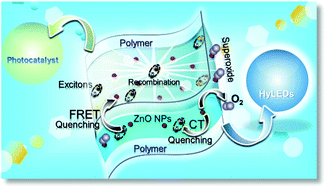Insights into the impact of photophysical processes and defect state evolution on the emission properties of surface-modified ZnO nanoplates for application in photocatalysis and hybrid LEDs†
Abstract
The effects of surface modification on the defect state densities, optical properties, and photocatalytic and quantum efficiencies of zinc oxide (ZnO) nanoplates were studied in this work. The aim of this study is to identify the photophysical processes that dictate the quenching of emission from defect states upon surface modification and the role of different defects such as zinc interstitials (Zni) or oxygen vacancies (VO) beside the photophysical processes in determining the photocatalytic efficiency of plate-like ZnO nanostructures. For controlling the intrinsic defect state densities of ZnO nanoplates, which is difficult to achieve, their surface was modified using different polymers such as PMMA and PVA. X-ray photoelectron spectroscopy (XPS) and photoluminescence (PL) emission spectroscopy were employed to identify and quantify the defect states. The analysis of relative defect state densities of Zni or VO showed that Zni significantly impacts the photocatalytic activity (PCA) besides VO, but it has a lower influence than VO because of the difference in the accessibility and intrinsic nature of these two defects. Synchronous quenching of emission from different defect states with different formation energies and its correlation with the photocatalytic activity led us to conclude that photophysical processes such as concentration-dependent Förster resonance energy transfer (FRET), charge transfer (CT) and Zni defects play a significant role behind PCA, which has been previously reported to be influenced by VO only. FRET and CT also play a critical role behind emission quenching upon surface modification. Upon the surface modification of nanoplates, a drop in the quantum efficiency from 12.14% to 4.44% was observed with the fine-tuning of emission colour from bluish-white to blue. Besides the defect states, FRET and CT phenomena are dominant in reducing the quantum efficiency of hybrid light-emitting diodes (HyLEDs) and photocatalytic efficiency. Therefore, the work outlines the reason behind the suppression of luminescence and photocatalytic efficiency of ZnO nanoparticles after surface modification and how to optimise them for their applications as an emissive layer in HyLEDs and efficient photocatalysts.



 Please wait while we load your content...
Please wait while we load your content...